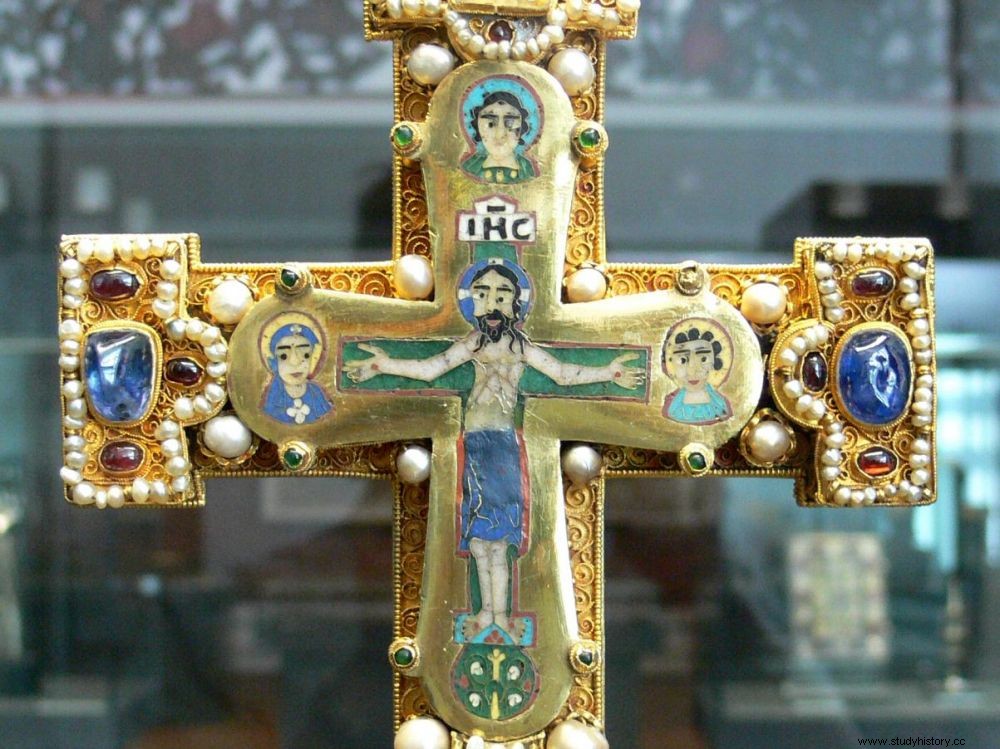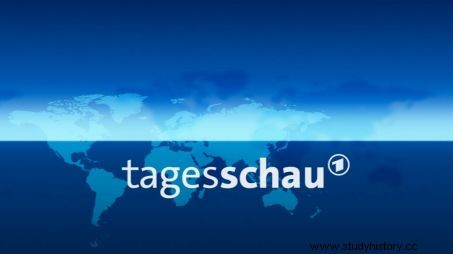The Germany press review evokes the recent judgment of the Supreme Court of the United States, which considers itself incompetent to decide on the status of the treasure of the Guelphs, a medieval ecclesiastical treasure bought by Germany in 1935 from a group of art dealers jews. Looted art or duly acquired art? The question is still unresolved. Also in the summary:the archaeologists of the Land of Schleswig-Holstein now prohibit the drafting of Enigma machines. German territorial waters are polluted by tons of dumped munitions. An exhibition in Berlin deconstructs the dehumanized gaze of racial anthropology.

Cross of the Guelphs, 12th century.
Summary-
The Treasure of the Guelphs, looted art?
-
Six Enigma resurface
-
Over a ton of ammo at sea
-
The cold gaze, exhibition in Berlin
The Treasure of the Guelphs, looted art?

In the soap opera which opposes the American heirs of German Jewish art dealers and the government of Angela Merkel concerning the treasure of the Guelphs, the Supreme Court of the United States declared its incompetence on Wednesday February 3, considering that it is a question of an internal German affair. The reliquary treasury of the former Church of St. Blaise in Brunswick originally included more than 80 pieces of goldsmithery made between the 11th and 15th centuries, including the famous Guelph cross, as well as portable altars and richly decorated reliquaries. decorated. The princely house of the Guelphs (Welfen) became its owner in 1671, but Duke Ernst-August of Brunswick-Lüneburg decided to part with it in 1929. A consortium of three renowned art dealers from Frankfurt am Main Main acquired and sold a number of them, before the Prussian state purchased the remaining 42 from them in 1935.
Since 2008, the heirs have been asking Germany for the return of the treasure, now on display at the Museum of Decorative Arts in Berlin, which they estimate to be worth at least 220 million euros. The German authorities having rejected their first requests, the case was brought in 2015 before a US court. Because in Germany there is no specific legislative tool intended for the restitution of works of art looted by the Nazis; the Limbach commission, although assigned to this task, only issues an advisory opinion; its recommendations have no legal value.
However, this commission precisely ruled in 2015 that the 1935 sale had taken place “in good and due form ”, and that the property had been legitimately acquired. On the contrary, the heirs consider that the sale took place under duress, the treasure having served as currency of exchange so that their families could leave Germany. The notion of “forced sale ”, corresponding to a violation of international law, was upheld by the American courts in 2017.
The heirs actually have various arguments suggesting that the acquisition of the Guelph treasury would be a matter of spoliation:the very low purchase price, the transfer of the sum to blocked accounts, the fact that the Minister-President of Prussia Hermann Göring himself operated to repatriate and thus “save " the treasure. Is it also possible to consider the sale of works of art from 1933 other than in the context of spoliation, asks the radio channel Deutsche Welle ?
Notwithstanding the decision just taken by the Supreme Court, the negotiations will continue on American soil, the court of first instance having to determine whether the art dealers then fully enjoyed their civil rights or whether they should be considered as stateless. The German government, however, is sticking to its guns. In 2015, the treasure of the Guelphs received the qualification of “cultural property of national value”, a classification which makes it impossible to leave the territory without authorization. The Treasury is more than ever under safe guard.
Enigmas are no longer enigmas
The Treasure of the Guelphs, looted art?

In the soap opera which opposes the American heirs of German Jewish art dealers and the government of Angela Merkel concerning the treasure of the Guelphs, the Supreme Court of the United States declared its incompetence on Wednesday February 3, considering that it is a question of an internal German affair. The reliquary treasury of the former church of Saint-Blaise de Brunswick originally included more than 80 pieces of goldsmithery made between the 11 th and the 15 th century, including the famous Guelph cross, as well as portable altars and richly decorated reliquaries. The princely house of the Guelphs (Welfen) became its owner in 1671, but Duke Ernst-August of Brunswick-Lüneburg decided to part with it in 1929. A consortium of three renowned art dealers from Frankfurt am Main Main acquired and sold a number of them, before the Prussian state purchased the remaining 42 from them in 1935.
Since 2008, the heirs have been asking Germany for the return of the treasure, now on display at the Museum of Decorative Arts in Berlin, which they estimate to be worth at least 220 million euros. The German authorities having rejected their first requests, the case was brought in 2015 before a US court. Because in Germany there is no specific legislative tool intended for the restitution of works of art looted by the Nazis; the Limbach commission, although devolved to this task, only issuing an advisory opinion, its recommendations have no legal value.
However, this commission precisely ruled in 2015 that the 1935 sale had taken place “in good and due form ”, and that the property had been legitimately acquired. On the contrary, the heirs consider that the sale took place under duress, the treasure having served as currency of exchange so that their families could leave Germany. The notion of “forced sale ”, corresponding to a violation of international law, was upheld by the American courts in 2017.
The heirs actually have various arguments suggesting that the acquisition of the Guelph treasury would be a matter of spoliation:the very low purchase price, the transfer of the sum to blocked accounts, the fact that the Minister-President of Prussia Hermann Göring himself operated to repatriate and thus “save " the treasure. Is it also possible to consider the sale of works of art from 1933 other than in the context of spoliation, asks the radio channel Deutsche Welle ?
Notwithstanding the decision just taken by the Supreme Court, the negotiations will continue on American soil, the court of first instance having to determine whether the art dealers then fully enjoyed their civil rights or whether they should be considered as stateless. The German government, however, is sticking to its guns. In 2015, the treasure of the Guelphs received the qualification of “cultural property of national value”, a classification which makes it impossible to leave the territory without authorization. The Treasury is more than ever under safe guard.
Enigmas are no longer enigmas

In November 2020, the discovery in Gelting Bay, in the Baltic Sea, of an Enigma, an encryption machine patented in 1918 and reserved for military use by the Wehrmacht since the mid-1920s, caused a stir. The professional diver who fished out six others at the mouth of the Schlei, south of Flensburg, at the end of January 2021, therefore thought he would receive a good welcome at the Land's archeology service. But the administration puts the kibosh:this kind of finds must not happen again.
We know perfectly well that this area of the Baltic Sea is home to a large amount of equipment dating from the Second World War, since a large part of the fleet had taken refuge there at the end of the conflict and that the crews, breaking the counter-order transmitted on 4 May 1945 by Admiral Dönitz who had negotiated the handing over of the buildings to the enemy, had scuttled submarines and ships. Not without having previously taken care to empty them of all valuable and useful objects and to deteriorate the remaining equipment, specifies the chain Deutschlandfunk; which explains the very poor condition of two of the last copies of the cipher machine fished out. The Land archaeologists therefore specify that it is of no scientific interest to multiply the specimens, because the Enigma machines are already well known and sufficiently documented, and because the restoration of all the specimens that could be found at sea would be a money pit.
What takes precedence, from a cultural and historical point of view, is the archaeological context of which they are part, this underwater heritage that must be preserved in its in situ state.> , in order to be able to analyze and document it. This is why archaeologists ask non-professionals not to touch any objects they might find at sea, but to note and photograph, then report the location to them. Finally, any search at the scene is also prohibited due to the high proportion of ammunition stored in the wrecks of ships and aircraft.
Tons of weapons pollute the Baltic Sea and the North Sea

All the countries bordering the North Sea and the Baltic Sea are in fact concerned by the danger posed by the gigantic quantities of weapons dumped during the last world conflicts:ammunition and mines washed ashore without having exploded, but above all 1.6 million tons of chemical and conventional weapons cast on the orders of the allies, as part of the demilitarization of defeated Germany in 1945.
The European Union has therefore implemented a project to detect these weapons, called BASTA and coordinated by the GEOMAR Helmholtz Center for Oceanographic Research in Kiel.
Thanks to autonomous underwater vehicles responsible for collecting and interpreting the data, the researchers were able to compile a cadastre listing the sites of explosive waste and the quantity of weapons in the seabed. They were thus able to identify still unknown locations, in particular in the Bay of Lübeck. The importance of this pioneering work – since it is the first time that such monitoring has been carried out at sea, stresses the Tagesschau –, lies not only in the use of artificial intelligence, but also in its extreme precision.
The other facet of the project consists in evaluating the toxicity of submerged devices by detecting the presence in the water of explosive compounds, more precisely TNT (trinitrotoluene) and its conversion products. Because the more the shells and the mines oxidize, the more these carcinogenic substances flow into the water. Toxicologists from the University of Kiel, who are also part of the project, monitor contamination levels by measuring them in the flesh of the mussels and in the water they filter. Across the Baltic Sea, researchers are now only detecting explosives at trace levels, but since the pollutant content is a function of the degree of oxidation, they hope that politicians will quickly order the cleaning of the seabed.
Frozen gazes

The exhibition entitled “The Cold Gaze”, presented at the Topography of Terror Foundation in Berlin, is “shocking ”, judges the weekly Die Zeit .
What is shocking is the corpus of anthropometric photographs taken in March 1942 by two young anthropologists, Elfriede Fliethmann and Dora Maria Kahlich, who went on a mission to the Polish town of Tarnów to carry out fieldwork there in accordance with the precepts of the anthropobiology, defined in 1913 by the anatomist Eugen Fischer as an “implementation in the practice of eugenics and racial hygiene ”. For twelve days, they will therefore “study” 106 Jewish families in the ghetto, examining and measuring 565 men, women and children using appropriate tools. Shots, taken by Rudolf Dodenhoff, support the carefully recorded data:portraits from the front, in profile, three-quarters, then the head tilted back (probably to show the shape of the nostrils), and nudes.
In 1999, the Viennese anthropologist Margit Berner found the box containing these numbered photographs, in the meantime expurgated of the naked shots. She then managed to identify the people depicted, with the help of historian Götz Aly.
Centered on these images, the Berlin exhibition demonstrates their “unshowability”; affixed to thin partitions in an impenetrable space, they escape the frontal gaze of visitors. Around this installation, other photographs document Jewish life in Tarnów, from deprivation in the ghetto to the extermination. Because six months after their investigation, the “equipment ” study of the two anthropologists had “already become rare ”, in their own words.
What is shocking is that the war and the Nazi regime allowed two young scientists to make a career by “throwing overboard all traditional ethical concerns ”, concludes journalist Stephan Speicher, quoting Götz Aly. But above all, “what not to forget ”, these are the images taken in 1942 by Rudolf Dodenhoff, who later became a famous landscape and architecture photographer and considered an artist, images which “are in themselves already testimonies of an absence of humanity, from a desire for annihilation ”.
